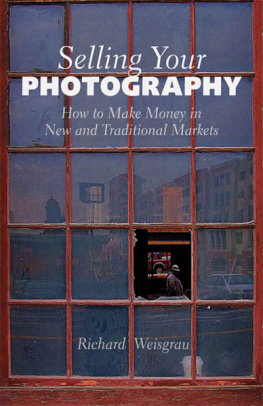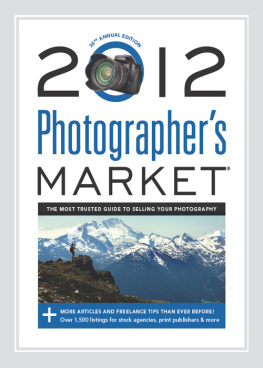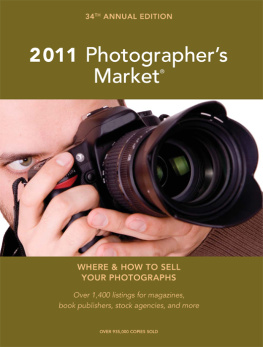

2009 Richard Weisgrau
All rights reserved. Copyright under Berne Copyright Convention,
Universal Copyright Convention, and Pan-American Copyright
Convention. No part of this book may be reproduced, stored in
a retrieval system, or transmitted in any form, or by any means,
electronic, mechanical, photocopying, recording, or otherwise,
without prior permission of the publisher.
13 12 11 10 09 5 4 3 2 1
Published by Allworth Press
An imprint of Allworth Communications, Inc.
10 East 23rd Street, New York, NY 10010
Cover design by Mary Belibasakis
Interior design by Joan OConnor
Page composition/typography by Integra Software Services, Pvt. Ltd.,
Pondicherry, India
ISBN-13: 978-158115-660-7
ISBN-10: 1-58115-660-X
eBook ISBN: 978-1-58115-726-0
Library of Congress Cataloging-in-Publication Data
Weisgrau, Richard.
Selling your photography / Richard Weisgrau.
p. cm.
ISBN 978-1-58115-660-7
1. Commercial photography. 2. PhotographyMarketing. I. Title.
TR690.W452 2009
770.688dc22
2009012499
Printed in The United States of America
 Contents
Contents
 Introduction
Introduction
T he market for publishable photographs is growing faster than ever before. With that growth, the demand for photographs of all types of subjects has increased. At the same time, technology has substantially reduced the need for technical expertise in making publishable photographs, and that has made aesthetics the main criteria for determining what will be published. The end result of market growth and new technology is that publishing photography is no longer the sole domain of the professional photographer. Today, the artistic amateur photographer who owns only moderately priced photography equipment has many opportunities to earn extra income by taking and selling photographs for publication.
Whether you are an amateur or professional photographer, the opportunities to publish your photographs are growing every day. Digital technology has created new and exciting media applications that need photographs. The World Wide Web craves an unending supply of photographs. Technology has also made the production of print publication simpler and less expensive. It has never been easier to include photographs in magazines, newspapers, newsletters, mailers, circulars, catalogs, brochures, calendars, posters, greeting cards, and other items that are now published in both print and electronic formats. Regardless of the media, those communications vehicles have one thing in common: they use photographs.
Many photographers believe that there is some special ingredient required to have a photograph published. That is a mistaken notion. There is only one: the photograph has to meet the needs of a person, company, or institution that publishes photographs. Meeting that need on a regular basis is not a matter of chance. It is a matter of studying the publication markets, planning an approach to selling photographs to those markets, and then implementing a plan. I wrote this book based upon my personal experience. Unlike my other books, written for the professional photographer, I wrote this book to help any photographer understand how to sell his photography in the publication marketplace. Publication photography is a business, but you dont have to be in the business on a daily basis to sell your photographs. To be successful at it requires that you have some business knowledge in addition to photographic talent and skills. Most of those business skills are covered in this book, but topics like business planning, copyright, and negotiating are not covered in their entirety. Like most business topics, the latter topics could be and are the subject of entire books, so I only present the basics knowledge required to sell your photography. But those basics are enough to get you started selling photographs and earning money. This book contains a reference section that lists other books you ought to read if you intend to sell your photography. Over time you can expand your knowledge and become more sophisticated at the process.
This book focuses on helping you understand the breadth and depth of the different market segments and the applications therein within the full spectrum of the publication photography marketplace. The book is aimed at helping you identify who publishes the kind of photographs you want to take and how you can sell your work to them. If you want to begin selling your photography, you ought to start by reading this book.
 Chapter 1
Chapter 1
Marketing
Opportunities
P hotographers have numerous outlets in which to publish their photography. Each year, these outlets spend billions of dollars to license the use of photographs for publication in a variety of media applications and for a variety of purposes. The publishers of photography are as vast as the landscape of society. Individuals, businesses, institutions, associations, sports teams, publishers, advertising agencies, public relations firms, government agencies, military services, greeting card companies, poster publishers, and calendar publishers are just a sampling of the outlets that need photographs for publication. Even better is the fact that they will pay for the use of the photographs in their publications.
Just think about newspapers alone. There are daily, weekly, biweekly, and monthly newspapers. Newspapers serve a wide variety of readers. Some are dedicated to sports or a particular sport. Some cover general interests. These newspapers can be international, national, regional, or local. Local can be a city or a village. While no one can produce an accurate count of the total number of newspapers that exist, it certainly has to be in the tens of thousands worldwide. As with newspapers, the volume of other published media applications is mind-boggling.
As a consultant, I had access to a study done by a major marketing research company that was commissioned by a major corporation to analyze the publication photography marketplace. That study identified 3,670,000 entities that purchased photography. A market that huge is full of opportunities to publish your photography. But to successfully seize some of these opportunities, you have to know how to select which ones to pursue and how to pursue them.
THE QUALIFIED PUBLICATION PHOTOGRAPHER

First of all, dont let the word qualified take on more meaning than it has. There are few qualifications for being photographer who makes publishable photographs. You have to make technically acceptable photographs. For 90 percent of the photographs you will take, a camera with automatic focus and automatic exposure will provide technically adequate photographs. The more challenging qualification is that you must make well-composed, aesthetically pleasing photographs. That requires some talent. Some are born with it. Others develop it by practice. Some never achieve it. The more talent you have, the more likely you are to be published regularly.
Next page













 Contents
Contents